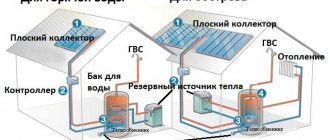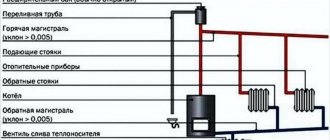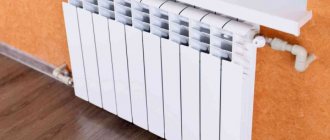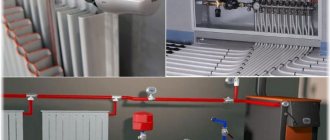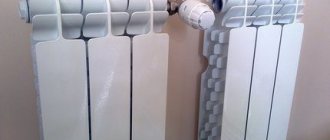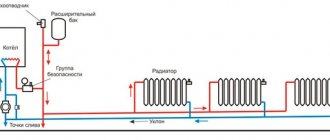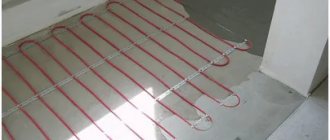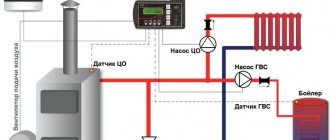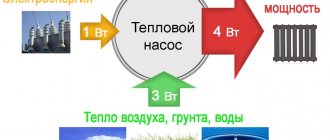Installation and commissioning of an energy-efficient, reliable and inexpensive heating system have always been one of the main issues at the stages of design and construction of housing stock. To create comfort for residents in the winter, it is necessary to calculate the heat load as accurately as possible and install the necessary heating components with high quality. From year to year there is a trend towards the need to reduce energy costs. Old, inefficient systems require urgent replacement with newer ones with better heat transfer performance. It is these collector heating systems that will be discussed in this article.
Types of heating systems and their differences
Heating systems are based on the principle of circulating hot water. Based on this, they distinguish:
- heating system with circulation based on natural pressure;
- heating system with circulation through a pump;
There is no need to dwell too much on the description of the first system, since this installation has long been considered obsolete and is practically not used in the construction of new housing due to its low efficiency. Such heating is used in small private houses and some public institutions. Let us just point out that its operation is based on the principle of the physical difference in the density of warm and cold water, which leads to its circulation.
A forced circulation heating system requires special pumps to provide circulation. This method makes it possible to practically heat a larger number of rooms than the first. Accordingly, this system is considered the most effective. There is a huge selection of pumps for circulating coolant in the system, which makes it possible to vary their power and other quality characteristics based on the size of the premises and their number.
A heating system with circulation by means of a pump is divided into:
- two-pipe (connecting radiators and pipes in parallel, which affects the speed and uniformity of heating);
- single-pipe (series connection of radiators, which determines the simplicity and low cost of installing a heating system).
The collector heating system is highly energy efficient compared to the above, due to the fact that each radiator is personally connected to one supply and one return pipeline, through which water is supplied using collectors.
Features of the collector system and its differences are as follows:
The manifold wiring of the heating system ensures that each radiator is independently regulated and does not depend on the operation of others. In addition, the collector system often uses other heating devices that also operate independently of the collectors. Radiators are mounted parallel to the collectors, which, according to the principle of operation, makes the collector system similar to a two-pipe one.
The installation of collectors is carried out in a separate utility room, or in a specially designated cabinet-stand hidden in the wall. The location for the collectors must be planned in advance, as they can be quite impressive in size. The dimensions of the distribution manifolds depend on the power of the radiators, which depend on the size of the rooms.
The manifold wiring of the heating system significantly outperforms the other heating systems listed above in the ability to dismantle and replace the radiator without the need to stop the entire system. Also, manifold wiring requires more piping for its operation than a two-pipe system. Despite significant one-time costs during the construction phase, these measures have a positive effect on the further energy efficiency of the system. That is why the collector heating system has the greatest effect and quickly pays for itself when building housing with a large area.
Advantages and disadvantages
The main advantages of the scheme, because of which “Leningradka” is so popular, are:
- low costs for materials;
- ease of installation.
It is worth noting that the first statement is very controversial; the price of materials depends very much on the selected pipe material. For example, if you take steel or polypropylene pipes, where fittings cost pennies, then a single-pipe “Leningrad” system will beat the two-pipe system in price.
It’s another matter when metal-plastic or polyethylene pipes are used for installation. Remember that the Leningrad distribution scheme provides for a large diameter supply line, while in a two-pipe system the pipe size will be smaller. Accordingly, larger diameter fittings are used, which means they will cost more and, in general, the cost of work and materials will be higher.
As for ease of installation, the statement is absolutely true. A person who understands the issue at least a little will calmly put together a “Leningradka” scheme. The difficulty lies elsewhere: before installation, careful calculation of the pipelines and radiator power is required, taking into account the significant cooling of the coolant. If you don’t do this and assemble the system at random, the result will be sad - only the first 3 batteries will heat up, the rest will remain cold.
In fact, the merits for which the “Leningradka” is so valued are very illusory. It is easy to install, but difficult to develop. It can boast of being cheap only if it is assembled from certain materials, and not everyone is satisfied with them.
An important drawback of the Leningrad scheme stems from its operating principle and lies in the fact that it is very problematic to regulate the heat transfer of batteries using thermostatic valves. The figure below shows the Leningrad heating system in a two-story house, where such valves are installed on radiators:
This scheme will always function inconsistently. As soon as the first radiator heats the room to the set temperature and the valve shuts off the supply of coolant, the bulk of it will rush to the second battery, the thermostat of which will also begin to operate. And so on until the very last device. When cooled, the process will repeat, only in reverse. When everything is calculated correctly, the system will heat more or less evenly, but if not, the last batteries will never heat up.
In the Leningrad scheme, the operation of all batteries is interconnected, so installing thermal heads is pointless; it is easier to balance the system manually.
And one last thing. "Leningradka" operates quite reliably with forced circulation of the coolant; it was conceived as part of a centralized heating network. When a non-volatile heating system without a pump is needed, then Leningradka is not the best option. To get good heat transfer with natural circulation, you need a two-pipe system or a vertical single-pipe system, shown in the figure:
Positive and negative aspects of the collector circuit
When planning the installation of heating with collector wiring, you should carefully study the technical side of the issue and determine all the positive and negative qualities of this system. Taking these qualities into account when building a house, you will be able to achieve its greatest energy efficiency.
Positive qualities of the collector system:
- direct control of each individual radiator of the system;
- a differentiated approach to heat distribution in each room, which makes it possible to effectively maintain the required temperature throughout the house, while saving money;
- ease of operation, the ability to access each component of the system without interfering with the operation of the others;
- aesthetic component, which consists in the possibility of installing the pipeline and auxiliary components of the system in the wall or floor;
- high payback associated with efficient consumption of energy resources.
Negative qualities:
- high costs at the initial stage of design and installation associated with the need to use pipes and additional components;
As you can see, there are not many disadvantages, they are not significant in comparison with the advantages of the system. Therefore, a collector heating system is rightfully considered the best solution today.
Installation and connection requirements
Performing all calculations, selecting equipment and components - all these are stages of designing collector heating. Installation of the system must be carried out taking into account the following requirements:
- intermediate units are placed only in dry rooms - pantries, corridors, closets and others. For additional protection, it is better to use special cabinets with stamping in the side parts, which allows you to quickly and comfortably connect pipelines;
- The expansion tank is located on the “return” section of the heating manifold circuit. This solution allows you to protect the unit from the negative effects of turbulent fluid flow, which sometimes occurs in this area;
- There are no strict requirements for the installation location of the circulation pump. However, it is most advisable to install it on the “return” circuit, this makes it possible to extend its service life. The pump shaft is placed strictly in a horizontal plane. Otherwise, the device may become airy, causing its internal elements to remain without lubrication and cooling, and accordingly, the pump will fail.
Compared to a tee collector heating system, it requires somewhat larger financial investments. However, thanks to efficiency, reliability, safety, high maintainability, as well as the possibility of economical use of energy resources, the investment pays off in a fairly short period of time.
Components of a manifold heating system
The configuration of a collector heating system is similar in its composition to a two-pipe (tee) system. The main, most expensive component is the boiler. The energy efficiency of the system depends on its effectiveness. The boiler power depends on the heated area and heat loss. In this regard, choosing a boiler and calculating its efficiency is a fairly serious part of the design, requiring consultation with a specialist.
In the background, they rightfully consider the level of heat transfer of the system, for which the radiators are responsible. But we should also not forget about possible heat loss. To minimize them, it is worth thinking about high-quality insulation of the house.
The manifold wiring of heating systems provides for a built-in pump for circulating coolant. The pump increases the heat transfer of the system, allowing the coolant to circulate as quickly as possible.
An important element of the system is the collector. The collector serves as a coolant distributor, facilitating efficient water supply. The collector consists of various regulators, valves, and temperature sensors that allow you to regulate the room temperature.
The principle of operation of the collector and how to choose it
The collector, or “comb”, as it is often called popularly, has at its base two main pipes (supply and return), to which nozzles are connected. Each such pipe has a continuation of the supply or return pipeline, respectively. A pump is installed on the supply manifold to circulate hot water.
A servo drive is mounted on the supply manifold to close the valve. When the water temperature reaches the specified parameters, the temperature sensor, when triggered, activates the servo drive, which presses the valve. The valve, in turn, blocks further water supply until the next moment it is cooled by a certain number of degrees.
After the heat is transferred through the radiator into the room, the water in the reverse circle of the system returns to the boiler, where it is heated again and supplied to the collector for further circulation.
Maintaining the required water pressure on the supply manifold is achieved by installing special regulators. They also regulate the required amount of water.
The choice of the required collector is influenced by the following factors:
- area of premises;
- number of radiators;
System design
The collector heating circuit includes the following elements:
- supply and return manifolds. Each of them is a metal comb, at the end of which a pipe from a heat supply source is connected, and on the sides there are outlets for connecting heating circuits. The number of taps may vary, depending on the modification. To obtain the desired heating configuration, it is possible to connect several combs together. Through the supply manifold, the coolant is supplied through the circuits to the heating devices. Through the return - collecting the cooled coolant and supplying it to the boiler;
- expansion tank. It is used to collect excess moisture, thereby preventing the occurrence of excess pressure in the heating system. It is especially relevant when installing collector wiring in a room with a large area or using a gas boiler as a heat supply source, which heats water to high temperatures. The volume of the expansion tank should not be less than 10% of the total volume of heating devices;
- circulation pump - designed to maintain the required liquid pressure in each circuit of the collector circuit. Helps to overcome the hydraulic elements of the collector system (pipes, radiators) through the movement of coolant flow. Particularly relevant for long pipeline lengths in the heating circuit;
- shut-off valves that ensure that each circuit of the collector wiring is turned on and off without compromising the operation of other circuits;
- heating radiators (if the collector system is radiator type);
- Mayevsky valves for heating devices or air release valves for the manifold are designed to bleed accumulated air in the system. They are a mandatory element, since airing pipes or heating devices prevents them from filling with coolant, which significantly reduces heat transfer rates;
- taps for draining water (mounted on the collector);
- heat energy consumption metering devices.
Pipe selection
The main point of installing collector wiring is the correct choice of pipes. In the installation of this system, a large number of connections are used, which entails the use of a large number of clamps and fittings. For this purpose, soft, flexible suture metal-plastic or polyethylene pipes are most suitable. Copper pipes are used to exit the pipes from the manifold.
These pipes have the properties of preventing air from entering due to a special coating on the outer surface.
The most optimal pipe diameter is 16 mm. However, you should consult a specialist on this issue.
Manifold wiring for heated floors
Installation of a heated floor using collector wiring is carried out similarly to a conventional water floor. You can install a heat transfer element under the floor covering and then connect it to the collector. Practice shows: it is possible to combine a collector for floor heating together with heating through radiators, but this should not be done. Multi-temperature systems.
It is worth remembering about thermal regulation: heated floors have less heat transfer, radiators have more.
The collector heating system today is the most efficient, economical, and quickly pays for itself. It is convenient, simple, and visually invisible, which makes living where it is installed as comfortable as possible.

